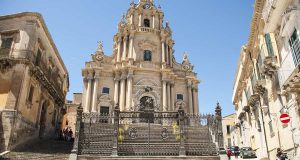Ragusa’s Church of the Annunziata is located inside the ancient Giudecca of the city. Destroyed by the earthquake of 1693, it was rebuilt in the 18th century by the Battaglia family of Torrevecchia. The façade was then rebuilt in the nineteenth century in neoclassical style. The church now houses the Museum of the Brotherhoods.
History of the former Church of the Annunziata in Ragusa
The first construction of the Church of the Annunziata in Ragusa dates back to the 16th century. Dedicated to the Madonna of Porto Salvo, it is located in the old Jewish quarter of Ibla. According to some sources, the building was built on the site of a synagogue. After being destroyed in the earthquake of 1693, the church was rebuilt in the 18th century. The work was entirely financed by Baron Battaglia di Torrevecchia, whose family had a private chapel inside the church. The arched bridge that connects the church of the Annunziata to the nearby Battaglia Giampiccolo palace can still be seen today. The façade was completely rebuilt in the 19th century in neoclassical style. Inside the church there is the Museo delle Confraternità (Museum of the Brotherhoods), which shows the life of the religious community in Ragusa.
Architecture and artwork of the church
The façade of the former church of the Annunziata in Ragusa is framed by pilasters with capitals in composite style, surmounted by squat domes. The portal, a semicircular arch, is surmounted by a triangular pediment. The interior has a single nave and a magnificent high altar in local stone and plaster. The altar is decorated with Baroque columns and in the center there is a sculptural group with the Annunciation of the Virgin and an angel from the 16th century. On the floor, near the high altar, there is a large slab of pitchstone that covers the tomb of the Battaglia family. Above it is engraved the coat of arms of the noble family. The ceiling of the church is frescoed with scenes from the life of the Madonna.
Aggiungi ai preferiti






























